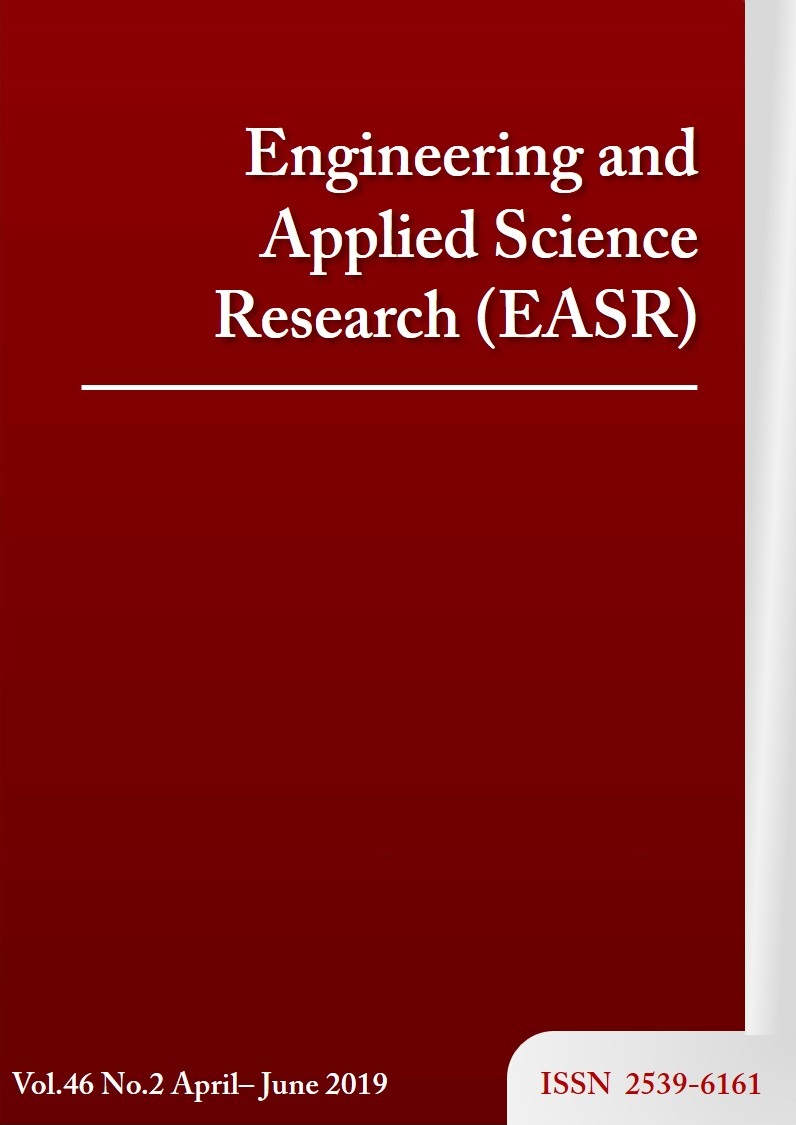Development of a non-thermal gliding-arc discharge reactor for biomass tar treatment
Main Article Content
Abstract
Non-thermal plasma technology is an interesting method for removal of tar from gasified biomass. In this study, AC gliding-arc reactors with a reverse vortex flow configuration were developed for biomass tar treatment. Successful generation of plasma discharge was obtained at high volume flows of treated gas. Preliminary experimental results showed that the onset of electric discharge occurred at about 10 kV. A large number of plasma discharges was evident. For our developed prototype, electric power input, total gas feed rate, and various carrier gases (Air, N2, N2+C10H8) were adjusted to investigate their effects on the discharge phenomena. The reverse vortex flow gliding arc discharges showed high residence times for potential chemical reactions inside the reactor. From preliminary tests, maximum removal efficiency of a representative tar compound of more than 93% was found, at an energy utilization efficiency of about 30 g/kWh.
Article Details
This work is licensed under a Creative Commons Attribution-NonCommercial-NoDerivatives 4.0 International License.
References
[2] Wongsiriamnuay T, Kunnang N, Tippayawong N. Effect of operating conditions on catalytic gasification of bamboo in a fluidized bed. Int J Chem Eng. 2013; 2013:1-9.
[3] Wongsiriamnuay T, Tippayawong N. Product gas distribution and composition from catalyzed gasification of mimosa. Int J Renew Energ Res. 2012; 2(3):363-8.
[4] Xu B, Xie J, Zhan H, Yin X, Wu C, Liu H. Removal of toluene as a biomass tar surrogate in a catalytic non-thermal plasma process. Energ Fuel. 2018;32(10):10709-19.
[5] Sasujit K, Dussadee N, Homdoung N, Ramaraj R, Kiatsiriroat T. Waste-to-energy: producer gas production from fuel briquette of energy crop in Thailand. Int Energ J. 2017;17(1):37-46.
[6] Capareda S. Introduction to biomass energy conversions. New York: CRC press; 2013.
[7] McKendry P. Energy production from biomass (part 3): gasification technologies. Bioresource Technol. 2002;83(1):55-63.
[8] Hernández JJ, Ballesteros R, Aranda G. Characterisation of tars from biomass gasification: Effect of the operating conditions. Energy. 2013;50 (1):333-42.
[9] Jin Q, Jiang B, Han J, Yao S. Hexane decomposition without particle emission using a novel dielectric barrier discharge reactor filled with porous dielectric balls. Chem Eng J. 2016;286:300-10.
[10] Yan K, Heesch EJMv, Pemen AJM, Huijbrechts PAHJ, Gompel FMv, Leuken Hv. A high-voltage pulse generator for corona plasma generation. IEEE Trans Ind Appl. 2002;38(3):866-72.
[11] Fridman A. Plasma chemistry. Cambridge: Cambridge University Press; 2008.
[12] Zhu J, Kusano Y, Li Z. Optical diagnostics of a gliding arc discharge at atmospheric pressure. In: Parker M, editor. Atmospheric pressure plasmas: processes, technology and applications. New York: Nova Science Publishers; 2016.
[13] Piavis W, Turn S. An experimental investigation of reverse vortex flow plasma reforming of methane. Int J Hydrogen Energ. 2012;37(22):17078-92.
[14] Xu G, Ding X. Optimization geometries of a vortex gliding-arc reactor for partial oxidation of methane. Energy. 2012;47(1):333-9.
[15] Kalra CS, Kossitsyn M, Iskenderova K, Chirokov A, Cho YI, Gutsol A, et al. Electrical discharges in the reverse vortex flow–tornado discharges. Electronic Proceedings of 16th International Symposium on Plasma Chemistry; 2003 Jun 22-27; Taormina, Italy. Bari: University of Bari; 2003.
[16] Kim HS, Wright KC, Hwang IW, Lee DH, Rabinovich A, Fridman A, et al. Concentration of hydrogen peroxide generated by gliding arc discharge and inactivation of E. coli in water. Int Comm Heat Mass Tran. 2013;42:5-10.
[17] Ren Y, Li X, Lu S, Yan J. Generation process and electric arc motion characteristics of DC vortex gliding arc plasma. IEEE Trans Plasma Sci. 2014;42(10):2702-3.
[18] Thanompongchart P, Tippayawong N. Experimental investigation of biogas reforming in gliding arc plasma reactors. Int J Chem Eng. 2014;2014:1-9.
[19] Tippayawong N, Inthasan P. Investigation of light tar cracking in a gliding arc plasma system. Int J Chem React Eng. 2010;8(1):1-15.
[20] Ren Y, Li X, Lu S, Yan J. Solid hazardous waste treatment and material modification by vortex gliding arc plasma. IEEE Trans Plasma Sci. 2014;42(10):2750-1.
[21] Yu L, Li X, Tu X, Wang Y, Lu S, Yan J. Decomposition of naphthalene by DC gliding arc gas discharge. J Phys Chem A. 2009;114(1):360-8.
[22] Ren Y, Li X, Wu A, Lu S, Yan J. Operation patterns and spectrum characteristics of DC and AC rotating gliding arc plasma. IEEE Trans Plasma Sci. 2014;42(10):2700-1.
[23] Chen FF. Introduction to plasma physics. New York: Springer Science & Business Media; 2012.
[24] Ren Y, Li X, Ji S, Lu S, Buekens A, Yan J. Removal of gaseous HxCBz by gliding arc plasma in combination with a catalyst. Chemosphere. 2014;117:730-6.
[25] Zhang H, Li L, Li X, Wang W, Yan J, Tu X. Warm plasma activation of CO2 in a rotating gliding arc discharge reactor. J CO2 Util. 2018;27:472-9.


